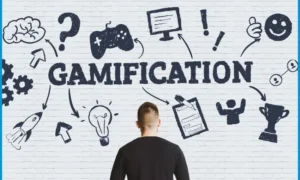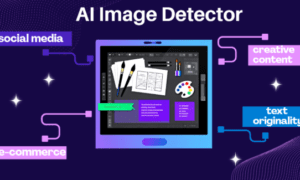Imagine a world where learning and work no longer feel like a grind, but instead become an exciting adventure. A world where every achievement is celebrated, progress is tangible, and motivation never runs dry. Welcome to the world of gamification – a revolutionary approach that’s changing the game in business and education.
As Gabe Zichermann, author of “Gamification by Design”, puts it: “Gamification is the process of using game thinking and game mechanics to engage users and solve problems.”
What’s the Deal with Gamification, Anyway?
At its heart, gamification is all about taking the elements that make games so engaging – things like points, levels, leaderboards, and challenges – and applying them to non-game contexts. It’s about tapping into our natural desire for reward, competition, and achievement, and using that to drive engagement and motivation.
Think about it: why do we love games so much? Is it just because they’re fun? Sure, that’s part of it. But there’s more to it than that. Games give us clear goals to strive for, immediate feedback on our progress, and a sense of mastery and accomplishment when we succeed. They make us feel like we’re part of something bigger than ourselves, whether we’re collaborating with teammates or competing against rivals.
Now, imagine if we could bottle that magic and sprinkle it over other areas of our lives. That’s exactly what gamification aims to do.
The Business of Play
In the business world, gamification is all the rage. Companies like Salesforce, Nike, and Deloitte are using gamified platforms and apps to supercharge their employees’ engagement and productivity.
Take Salesforce, for example. They’ve created a platform called “Salesforce Motivate” that turns sales into a game. Teams compete against each other to hit targets, unlock achievements, and climb the leaderboards. It’s not just about racking up points – it’s about fostering a culture of collaboration, learning, and continuous improvement.
Or look at Nike. Their “Nike+” app uses challenges, rewards, and social features to motivate users to exercise more and stay active. By turning fitness into a game, they’re not just selling sneakers – they’re building a loyal community of brand advocates.
Another great example is Recyclebank, an eco-friendly store that uses gamification to encourage people to recycle. Users earn points for recycling, which they can then redeem for discounts at partner stores.
And it’s not just about fun and games. Gamification can have real, measurable impacts on business outcomes. Studies have shown that gamified training programs can boost knowledge retention by up to 90%, compared to traditional methods. Gamified sales teams can close deals faster and more often. Gamified customer loyalty programs can drive repeat business and higher lifetime value.
Level Up Your Learning
Education is another area where gamification is making waves. From elementary schools to corporate training programs, educators are using game-based learning to engage students and drive better outcomes.
One of the pioneers in this space is Duolingo, the wildly popular language learning app. Duolingo turns language acquisition into a game, with points, levels, and rewards for hitting your daily practice goals. It’s not just a gimmick – studies have shown that Duolingo users can learn a language as effectively as students in traditional classroom settings, in half the time.
But it’s not just about language learning. Gamification is being used to teach everything from math and science to soft skills like leadership and communication. Platforms like Kahoot! and Quizizz allow teachers to create interactive, competitive quizzes that students love. Simulations and role-playing games let learners practice real-world skills in a safe, low-stakes environment.
The Habitica app is another great example of gamification in action. It helps users build good habits and improve their productivity by turning tasks into quests, rewards, and challenges.
And in the era of remote and hybrid learning, gamification can be a lifeline for keeping students engaged and motivated. When you can’t be in the same room as your students, game-based learning can help bridge the gap and create a sense of community and competition.
| Traditional Methods | Gamification |
| Passive learning | Active engagement |
| Extrinsic motivation (grades, punishments) | Intrinsic motivation (curiosity, fun) |
| Focus on outcomes | Focus on process and progress |
| Monotony and routine | Variety and novelty |
The Psychology of Play
So what is it about gamification that makes it so effective? The answer lies in the psychological principles that underpin it.
One key theory is Self-Determination Theory, which suggests that we are most motivated when we feel a sense of autonomy (choice and control over our actions), competence (mastery and growth), and relatedness (connection to others). Games are great at hitting all three of these notes – they give us agency, challenge us to improve, and often involve social interaction.
Another important concept is Flow Theory, which describes the optimal state of engagement where a task is challenging enough to stretch our skills, but not so hard that we get discouraged. The best games are great at keeping us in this “flow zone”, where time seems to fly by and we’re fully immersed in the experience.
By tapping into these deep psychological needs and states, gamification can create experiences that are not just effective, but truly transformative.
The Dark Side of Gamification
Now, gamification isn’t a magic bullet. Like any tool, it can be used poorly or inappropriately. There are some potential pitfalls to watch out for:
- Oversimplification: Sometimes, in the quest to make things “fun,” we can end up dumbing them down. Points and badges are great, but they’re not a substitute for deep, meaningful learning.
- Manipulation: Gamification can be used to exploit people’s psychological vulnerabilities, like FOMO (fear of missing out) or social comparison. It’s important to use these tactics ethically and responsibly.
- Burnout: If every aspect of our lives becomes a game, we risk feeling constantly pressured to perform and compete. It’s important to strike a balance and leave room for rest, reflection, and intrinsic motivation.
But when done right, gamification has the power to transform the way we learn, work, and grow. By tapping into the best aspects of games – the sense of adventure, the thrill of mastery, the joy of collaboration – we can create experiences that are not just effective, but truly engaging.
The Future Is Playful
So what does the future hold for gamification? As technology advances and our understanding of motivation evolves, the possibilities are endless.
We’re already seeing gamification being used in fields like healthcare, where apps like Zombies, Run! turn exercise into a thrilling audio adventure. In finance, apps like Mint and Acorns use game-like features to encourage saving and investing.
As virtual and augmented reality become more sophisticated, we can expect to see even more immersive and interactive gamified experiences. Imagine practicing your public speaking skills in a virtual auditorium, or learning history by exploring a gamified recreation of ancient civilizations.
But perhaps the most exciting frontier for gamification is in the realm of social impact. Can we use game design principles to encourage recycling, volunteering, or civic engagement? Can we create games that promote empathy, compassion, and understanding across cultures and communities?
These are the kinds of questions that the next generation of gamification pioneers will be exploring. And I, for one, can’t wait to see what they come up with.
Gamification in the Age of Remote Work and Learning
In the wake of the COVID-19 pandemic, remote work and online education have become the new normal for many of us. And in this context, gamification has taken on a whole new level of importance.
When we’re not sharing a physical space with our colleagues or classmates, it can be easy to feel disconnected and unmotivated. Gamification can help bridge that gap by creating virtual environments that foster engagement, collaboration, and friendly competition.
From virtual team-building exercises to gamified onboarding programs, companies are finding creative ways to keep their remote workforce connected and motivated. And in online classrooms, teachers are using gamification to make distance learning more interactive and rewarding for students.
As one student put it: “With everything being online now, it’s hard to stay focused and motivated. But my gamified math class has been a lifesaver. Earning points and badges for completing assignments actually makes me want to do the work, and competing with my classmates keeps me on my toes.”
Press Start to Continue
So there you have it – a whirlwind tour of the world of gamification. From the boardroom to the classroom, from the gym to the metaverse, this powerful approach is changing the way we think about engagement and motivation.
Whether you’re a business leader looking to boost your team’s performance, an educator seeking to inspire your students, or just a curious individual looking to level up your life, gamification has something to offer.
But don’t just take my word for it. The best way to understand gamification is to experience it for yourself. So go ahead – pick up that language learning app, join that fitness challenge, or enroll in that gamified training program. See how it feels to turn work into play, and learning into adventure.
Who knows? You might just discover a whole new level of motivation and engagement that you never knew you had. And in the end, isn’t that what life’s all about – growing, improving, and having fun along the way?
So what are you waiting for? Press start and let the games begin!



































